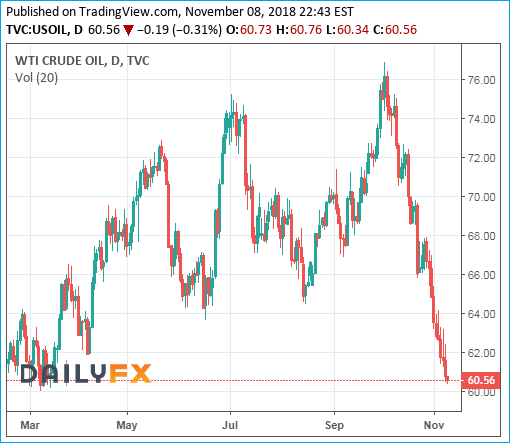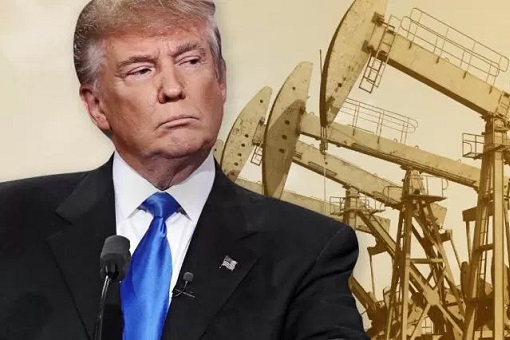WTI Crude prices dropped for a ninth consecutive session on Thursday, essentially falling into a bear market, and it could get worse. In fact, the U.S. oil prices have plunged over the last 5 weeks since early October. And if the U.S. oil benchmark continues to drop like a rock in a “ferocious” bear market, analyst Jim Cramer thinks WTI could drop to US$40 a barrel.
Effectively, at the current US$60.56 price, the U.S. oil prices are down 21% from last month’s four-year high of US$76.90 (Oct 3), entering bear market territory. That was when the world was worried that much more Iranian oil than initially thought would come off the market due to the U.S. sanctions on Tehran. But as it turned out, President Trump blinked and decided to be flexible.
Trump administration announced it would issue waivers to eight countries, allowing them to continue importing Iranian crude for the next 180 days. Hence, the loss of Iranian supplies is estimated to be between 1 and 1.2 million barrels per day only, and the OPEC and non-OPEC producers have already more than made up for that – contributing to the excess oil in the market.

Adding salt to the injury, the U.S. Energy Information Administration (EIA) reported on Wednesday the seventh consecutive weekly increase in U.S. crude stockpiles. U.S. output also hit an all-time high at 11.6 million barrels per day last week. If the data is confirmed, it means the United States has snatched the crown away from Russia as the world’s largest oil producer.
But the party has just begun. The EIA forecast this week that U.S. oil production will average 12.1 million bpd (barrels per day) in 2019, marking an upward revision from its last projection. Production has not just risen in the United States, but also in many other countries – including Russia, Saudi Arabia, Iraq and Brazil, Iraq, U.A.E. and even Indonesia.
In fact, the falling crude oil prices have been so spectacular that President Donald Trump on Wednesday has taken credit for it. He said – “If you look at oil prices they’ve come down very substantially over the last couple of months. That’s because of me. Because you have a monopoly called OPEC, and I don’t like that monopoly.”

Trump can claim some credit – but not all – behind the oil price pullback. True, he was the one who asked – even threatened – OPEC cartel leader Saudi Arabia to pump more oil to offset the impact of sanctions on Iran. Actually, OPEC and its oil market allies were also concerned that rising prices would shrink demand for oil, hence gladly did as Trump’s order.
But Donald Trump was also the one who actually started the tension with Iran in the first place by bringing back sanctions on the country, targeting banking, shipping and oil. It was only when the oil prices continued skyrocketing that the U.S. president gives exemptions to 8 countries – China, India, Italy, Greece, Japan, South Korea, Taiwan and Turkey.
However, by the time Trump realized his mistake and decided to grant the exceptions, the world was already well prepared – storing more oil in advance. Trump said – “We’re going to let some of the oil go out to these countries that really do need it, because I don’t want to drive the oil prices up to $100 or $150 a barrel, which could happen very easily.” Obviously, that’s an admission of his mistake.

Thanks to Trump’s trade war with China, the slowing in world economy means demand is slowing for oil. However, trade data released by China on Thursday showed the country’s oil imports rose to an all-time high at 9.61 million bpd in October. But it’s not sure whether they were for consumption or merely storage for the rainy day.
Nevertheless, there was this growing consensus among analysts and economists that global oil consumption will not expand as much as previously anticipated. Therefore, forecasters are knocking down their projections for oil demand due to concerns about global economic growth largely because of Trump’s trade dispute with China and currency weakness in emerging markets.
Still, the bearish crude oil may be short-lived and we may not see US$40 a barrel at all if OPEC and Russia decide to cut their supply aggressively. A committee representing OPEC and non-OPEC producers is set to meet this weekend and could make a recommendation that the crude oil is low enough to start production cut to push up the price back to US$70 a barrel.

However, now that the WTI Crude has entered the bear territory, it won’t enter a bull market until it rises 20%. The bull market was the longest since a 350-day run that ended on January 28, 2015. But it won’t be a walk in the park for the oil to just shoot from the present US$60 to US$76 a barrel, considering the global slowing economy as a result of the U.S.-China trade war.
Other Articles That May Interest You …
- Trump In Trouble As Democrats Snatch The House!! – But The Stock Market Cheers The President Is Being “Checked”
- Trump’s Trade War & Potential More Sanctions are Pushing China Closer To Russia
- Forget U.S.-China Boring Trade War – Saudi & Canada Diplomatic Feud Has Become Financial War
- BOOM!! – Here’s Why Oil Prices Sink To 8-Week Low, Despite Saudi Production Cut & Iran Sanctions
- China’s Latest Strategy Against Trump’s Trade War May Be Based On Sun Tzu’s Art Of War – Stays Quiet!!
- BOOM!! – Crude Oil Prices Drop Spectacularly From Its $80 High, And Here’s Why It Will Continue To Fall
- Obedience!! Saudi-Led OPEC Ministers Agree To Raise Oil Production – Because Trump Orders Them To

|
|
November 9th, 2018 by financetwitter
|


|

|

|

|

|

|




























Comments
Add your comment now.
Leave a Reply